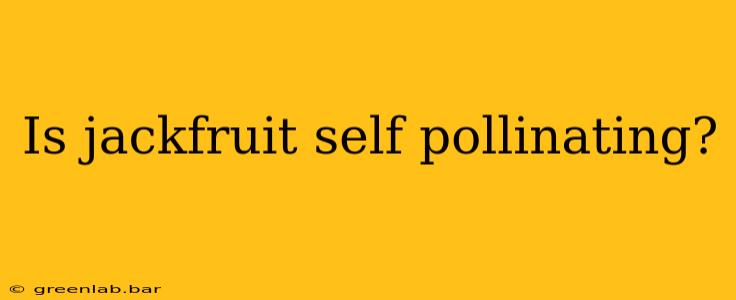Jackfruit, the world's largest tree-borne fruit, presents an interesting case when it comes to pollination. While often perceived as a straightforward process, understanding jackfruit's reproductive biology reveals a more nuanced picture. The simple answer is: no, jackfruit is not strictly self-pollinating. However, it displays characteristics that blur the lines between self-pollination and cross-pollination, making it a fascinating subject for botanists and horticulturists alike.
The Mechanics of Jackfruit Pollination
Jackfruit trees are monoecious, meaning they bear both male and female flowers on the same tree. However, these flowers are not simultaneously receptive. This temporal separation of male and female flower receptivity significantly reduces the likelihood of self-pollination.
- Male flowers: These bloom first and release pollen, often in abundance. The pollen is typically wind-dispersed.
- Female flowers: These open later and are receptive to pollen. While they can potentially receive pollen from the same tree, the timing difference makes this less probable.
This asynchronous flowering is a key factor in jackfruit's reproductive strategy. It encourages cross-pollination, leading to greater genetic diversity within the offspring. Cross-pollination, facilitated by wind, insects (like bees and wasps), and even bats, results in healthier and more robust jackfruit trees and fruits.
The Role of Wind and Insects
While wind plays a significant role in dispersing pollen, insects also contribute to jackfruit pollination. Many insects are attracted to the fragrant male flowers, inadvertently carrying pollen to the later-blooming female flowers. This secondary pollination pathway increases the chances of successful fertilization, even if wind dispersion is limited.
Factors Affecting Jackfruit Pollination
Several factors can influence the success of jackfruit pollination:
- Climate: Temperature and rainfall patterns directly impact flower development and pollen viability.
- Tree health: Stressed or unhealthy trees may produce fewer or less viable flowers, reducing pollination chances.
- Pollinator availability: The abundance of wind and insects in the surrounding environment can affect the overall pollination rate.
- Flowering synchrony: Even minor variations in the timing of male and female flower blooming can affect self-pollination success.
Practical Implications for Jackfruit Growers
Understanding the intricacies of jackfruit pollination is crucial for successful cultivation. While not reliant on cross-pollination in the strictest sense, promoting cross-pollination through planting multiple varieties and maintaining a healthy environment leads to better fruit yield and quality.
Planting multiple jackfruit cultivars near each other helps maximize chances of cross-pollination, leading to increased fruit set and potentially larger, healthier fruits. Maintaining a healthy ecosystem that supports insect populations also indirectly boosts pollination success.
Conclusion
While jackfruit trees possess the capability of self-pollination, the asynchronous blooming of male and female flowers strongly favors cross-pollination. This natural inclination towards cross-pollination results in greater genetic diversity and improved fruit production. For optimal yields, growers should focus on creating conditions that encourage cross-pollination, promoting healthy trees and robust insect populations.

